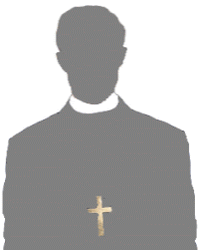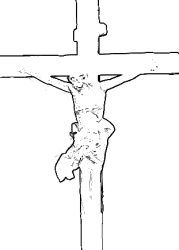Roman Catholic
St Sigismund parish
05-507 Słomczyn
85 Wiślana Str.
Konstancin deanery
Warsaw archdiocese, Poland
full list:
displayClick to display full list

searchClick to search full list by categories
wyświetlKliknij by wyświetlić pełną listę po polsku

szukajKliknij by przeszukać listę wg kategorii po polsku

Martyrology of the clergy — Poland
XX century (1914 – 1989)
personal data

surname
KACZOR-KACZOROWSKI
forename(s)
Nicholas (pl. Mikołaj)

function
diocesan priest
creed
Latin (Roman Catholic) Church RCmore on
en.wikipedia.org
[access: 2014.09.21]
diocese / province
Lviv archdiocesemore on
en.wikipedia.org
[access: 2013.05.19]
alt. dates and places
of death
03.1937 (after)
ITL BelBaltLagGuLAG slave labour camp network
today: Medviezhyegorsk, Karelia rep., Russia
more on
en.wikipedia.org
[access: 2022.01.09]
details of death
Arrested on 03.04.1935.
In 10.1935 sentenced to 5 years of slave labour.
Transported to ITL BelbaltLag, to Medviezhyegorsk by Kirow railroad.
There got paralysed.
In 03.1937 still jailed there.
Fate thereafter unknown.
cause of death
murder
perpetrators
Russians
sites and events
Great Purge 1937Click to display the description, ITL BelbaltLagClick to display the description, GulagClick to display the description, Ribbentrop‐MolotovClick to display the description, Pius XI's encyclicalsClick to display the description
positions held
priest — Borshchivtoday: Borshchiv urban hrom., Chortkiv rai., Ternopil obl., Ukraine
more on
en.wikipedia.org
[access: 2020.11.20] ⋄ Holy Trinity RC parish ⋄ Borshchivtoday: Borshchiv urban hrom., Chortkiv rai., Ternopil obl., Ukraine
more on
en.wikipedia.org
[access: 2020.11.20] RC deanery
sites and events
descriptions
Great Purge 1937: „Great Terror” (also «Great Purge», also called „Yezhovshchyna” after the name of the then head of the NKVD) — a Russian state action of political terror, planned and directed against millions of innocent victims — national minorities, wealthier peasants (kulaks), people considered opponents political, army officers, the greatest intensity of which took place from 09.1936 to 08.1938. It reached its peak starting in the summer of 1937, when Art. 58‐14 of the Penal Code about „counter‐revolutionary sabotage” was passed , which became the basis for the „legalization” of murders, and on 02.07.1937 when the highest authorities of Russia, under the leadership of Joseph Stalin, issued a decree on the initiation of action against the kulaks. Next a number of executive orders of the NKVD followed, including No. 00439 of 25.07.1937, starting the liquidation of 25,000‐42,000 Germans living in Russia (mainly the so‐called Volga Germans); No. 00447 of 30.07.1937, beginning the liquidation of „anti‐Russian elements”, and No. 00485[2] of 11.08.1937, ordering the murder of 139,835 people of Polish nationality (the latter was the largest operation of this type — encompassed 12.5% of all those murdered during the «Great Purge», while Poles constituted 0.4% of the population). In the summer of 1937 Polish Catholic priests held in Solovetsky Islands, Anzer Island and ITL BelbaltLag were locked in prison cells (some in Sankt Petersburg). Next in a few kangaroo, murderous Russian trials (on 09.10.1937, 25.11.1937, among others) run by so‐called «NKVD Troika» all were sentenced to death. They were subsequently executed by a single shot to the back of the head. The murders took place either in Sankt Petersburg prison or directly in places of mass murder, e.g. Sandarmokh or Levashov Wilderness, where their bodies were dumped into the ditches. Other priests were arrested in the places they still ministered in and next murdered in local NKVD headquarters (e.g. in Minsk in Belarus), after equally genocidal trials run by aforementioned «NKVD Troika» kangaroo courts.
ITL BelbaltLag: Russian Rus. Исправи́тельно‐Трудово́й Ла́герь (Eng. Corrective Labor Camp) ITL Rus. Беломоро‐Балтийский (Eng. White Sea ‐ Baltic Sea) — concentration and slave forced labor camp (within the Gulag complex) — headquartered in Medvezhjegorsk on Lake Onega, and in 1933‐1934 also in the town of Nadvoytsy (both then in the Karelo‐Finnish Republic, today the Karelian Republic). Founded on 16.11.1931, on the basis of the former ITL SLON camp (i.a. on the Solovetsky islands on the White Sea). Prisoners slaved at the construction of a canal between the White Sea and the Baltic Sea (opened on 30.06.1933). Later, as part of the newly created White Sea ‐ Baltic Sea Combine, managed by the criminal GPU (later the genocidal NKVD), slaved on forest clearing, in sawmills, on the construction of factories for wooden products and paper production, on the construction of hydroelectric power plants (Tulomskaya and Onda), a nickel factory and alcohol distilleries, construction of ports, and laying of railway lines., etc. One of heads of the camp was a Jew, Naftali Frenkel, regarded as the originator of the Gulag system. At its peak c. 110,000 prisoners were held there: e.g. 107,900 (12.1932); 70,373 (01.01.1934); 66,418 (01.01.1935); 90,290 (01.01.1936); 58,965 (01.01.1937); 79,232 (01.10.1938); 86,567 (01.01.1939); 71,269 (01.01.1941); 67,928 (15.06.1941). In 1938 there were 3,946 women among them. According to official data, 12,300 perished during the construction of the canal itself — according to unofficial data, from 50,000 to 300,000. The camp operated until 18.09.1941, and the entire project — in economic terms — turned out to be a total failure. (more on: ru.wikipedia.orgClick to attempt to display webpage
[access: 2022.09.02], en.wikipedia.orgClick to attempt to display webpage
[access: 2014.05.09])
Gulag: The acronym Gulag comes from the Rus. Главное управление исправительно‐трудовых лагерей и колоний (Eng. Main Board of Correctional Labor Camps). The network of Russian concentration camps for slave labor was formally established by the decision of the highest Russian authorities on 27.06.1929. Control was taken over by the OGPU, the predecessor of the genocidal NKVD (from 1934) and the MGB (from 1946). Individual gulags (camps) were often established in remote, sparsely populated areas, where industrial or transport facilities important for the Russian state were built. They were modeled on the first „great construction of communism”, the White Sea‐Baltic Canal (1931‐1932), and Naftali Frenkel, of Jewish origin, is considered the creator of the system of using forced slave labor within the Gulag. He went down in history as the author of the principle „We have to squeeze everything out of the prisoner in the first three months — then nothing is there for us”. He was to be the creator, according to Alexander Solzhenitsyn, of the so‐called „Boiler system”, i.e. the dependence of food rations on working out a certain percentage of the norm. The term ZEK — prisoner — i.e. Rus. заключенный‐каналоармец (Eng. canal soldier) — was coined in the ITL BelBaltLag managed by him, and was adopted to mean a prisoner in Russian slave labor camps. Up to 12 mln prisoners were held in Gulag camps at one time, i.e. c. 5% of Russia's population. In his book „The Gulag Archipelago”, Solzhenitsyn estimated that c. 60 mln people were killed in the Gulag until 1956. Formally dissolved on 20.01.1960. (more on: en.wikipedia.orgClick to attempt to display webpage
[access: 2024.04.08])
Ribbentrop‐Molotov: Genocidal Russian‐German alliance pact between Russian leader Joseph Stalin and German leader Adolf Hitler signed on 23.08.1939 in Moscow by respective foreign ministers, Mr. Vyacheslav Molotov for Russia and Joachim von Ribbentrop for Germany. The pact sanctioned and was the direct cause of joint Russian and German invasion of Poland and the outbreak of the World War II in 09.1939. In a political sense, the pact was an attempt to restore the status quo ante before 1914, with one exception, namely the „commercial” exchange of the so‐called „Kingdom of Poland”, which in 1914 was part of the Russian Empire, fore Eastern Galicia (today's western Ukraine), in 1914 belonging to the Austro‐Hungarian Empire. Galicia, including Lviv, was to be taken over by the Russians, the „Kingdom of Poland” — under the name of the General Governorate — Germany. The resultant „war was one of the greatest calamities and dramas of humanity in history, for two atheistic and anti‐Christian ideologies — national and international socialism — rejected God and His fifth Decalogue commandment: Thou shall not kill!” (Abp Stanislav Gądecki, 01.09.2019). The decisions taken — backed up by the betrayal of the formal allies of Poland, France and Germany, which on 12.09.1939, at a joint conference in Abbeville, decided not to provide aid to attacked Poland and not to take military action against Germany (a clear breach of treaty obligations with Poland) — were on 28.09.1939 slightly altered and made more precise when a treaty on „German‐Russian boundaries and friendship” was agreed by the same murderous signatories. One of its findings was establishment of spheres of influence in Central and Eastern Europe and in consequence IV partition of Poland. In one of its secret annexes agreed, that: „the Signatories will not tolerate on its respective territories any Polish propaganda that affects the territory of the other Side. On their respective territories they will suppress all such propaganda and inform each other of the measures taken to accomplish it”. The agreements resulted in a series of meeting between two genocidal organization representing both sides — German Gestapo and Russian NKVD when coordination of efforts to exterminate Polish intelligentsia and Polish leading classes (in Germany called «Intelligenzaktion», in Russia took the form of Katyń massacres) where discussed. Resulted in deaths of hundreds of thousands of Polish intelligentsia, including thousands of priests presented here, and tens of millions of ordinary people,. The results of this Russian‐German pact lasted till 1989 and are still in evidence even today. (more on: en.wikipedia.orgClick to attempt to display webpage
[access: 2015.09.30])
Pius XI's encyclicals: Facing the creation of two totalitarian systems in Europe, which seemed to compete with each other, though there were more similarities than contradictions between them, Pope Pius XI issued in 03.1937 (within 5 days) two encyclicals. In the „Mit brennender Sorge” (Eng. „With Burning Concern”) published on 14.03.1938, condemned the national socialism prevailing in Germany. The Pope wrote: „Whoever, following the old Germanic‐pre‐Christian beliefs, puts various impersonal fate in the place of a personal God, denies the wisdom of God and Providence […], whoever exalts earthly values: race or nation, or state, or state system, representatives of state power or other fundamental values of human society, […] and makes them the highest standard of all values, including religious ones, and idolizes them, this one […] is far from true faith in God and from a worldview corresponding to such faith”. On 19.03.1937, published „Divini Redemptoris” (Eng. „Divine Redeemer”), in which criticized Russian communism, dialectical materialism and the class struggle theory. The Pope wrote: „Communism deprives man of freedom, and therefore the spiritual basis of all life norms. It deprives the human person of all his dignity and any moral support with which he could resist the onslaught of blind passions […] This is the new gospel that Bolshevik and godless communism preaches as a message of salvation and redemption of humanity”… Pius XI demanded that the established human law be subjected to the natural law of God , recommended the implementation of the ideal of a Christian state and society, and called on Catholics to resist. Two years later, National Socialist Germany and Communist Russia came together and started World War II. (more on: www.vatican.vaClick to attempt to display webpage
[access: 2023.05.28], www.vatican.vaClick to attempt to display webpage
[access: 2023.05.28])
sources
personal:
biographies.library.nd.eduClick to attempt to display webpage
[access: 2014.12.20]
LETTER to CUSTODIAN/ADMINISTRATOR
If you have an Email client on your communicator/computer — such as Mozilla Thunderbird, Windows Mail or Microsoft Outlook, described at WikipediaPatrz:
en.wikipedia.org, among others — try the link below, please:
LETTER to CUSTODIAN/ADMINISTRATORClick and try to call your own Email client
If however you do not run such a client or the above link is not active please send an email to the Custodian/Administrator using your account — in your customary email/correspondence engine — at the following address:

giving the following as the subject:
MARTYROLOGY: KACZOR-KACZOROWSKI Nicholas
To return to the biography press below:
 Click to return to biography
Click to return to biography








